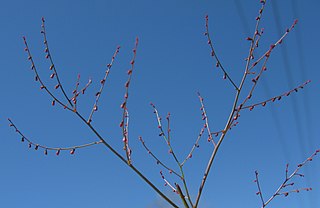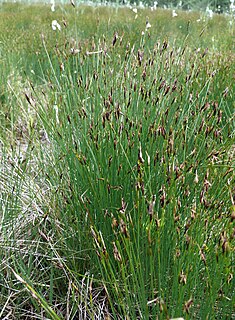
Scaevola is a genus of flowering plants in the Goodenia family, Goodeniaceae. It consists of more than 130 species, with the center of diversity being Australia and Polynesia. There are around 80 species in Australia, occurring throughout the continent, in a variety of habitats. Diversity is highest in the South West, where around 40 species are endemic.

The Combretaceae, often called the white mangrove family, are a family of flowering plants in the order Myrtales. The family includes about 530 species of trees, shrubs, and lianas in ca 10 genera. The family includes the leadwood tree, Combretum imberbe. Three genera, Conocarpus, Laguncularia, and Lumnitzera, grow in mangrove habitats (mangals). The Combretaceae are widespread in the subtropics and tropics. Some members of this family produce useful construction timber, such as idigbo from Terminalia ivorensis. The commonly cultivated Quisqualis indica is now placed in the genus Combretum. Many plants in the Quisqualis species contain the Non-proteinogenic amino acid excitotoxin Quisqualic acid, a potent AMPA agonist.

Elaeocarpus is a genus of nearly five hundred species of flowering plants in the family Elaeocarpaceae native to the Western Indian Ocean, Tropical and Subtropical Asia, and the Pacific. Plants in the genus Elaeocarpus are trees or shrubs with simple leaves, flowers with four or five petals usually, and usually blue fruit.

Muehlenbeckia or maidenhair is a genus of flowering plants in the family Polygonaceae. It is native to the borders of the Pacific, including South and North America, Papua New Guinea and Australasia. It has been introduced elsewhere, including Europe. Species vary in their growth habits, many being vines or shrubs. In some environments, rampant species can become weedy and difficult to eradicate.

Olearia, most commonly known as daisy-bush, is a genus of flowering plants belonging to the family Asteraceae, the largest of the flowering plant families in the world. Olearia are found in Australia, New Guinea and New Zealand. The genus includes herbaceous plants, shrubs and small trees. The latter are unusual among the Asteraceae and are called tree daisies in New Zealand. All bear the familiar daisy-like composite flowerheads in white, pink, mauve or purple.

Commersonia is a genus of twenty-five species of flowering plants in the family Malvaceae. Plants in this genus are shrubs or trees, occurring from Indochina to Australia and have stems, leaves and flowers covered with star-like hairs. The leaves are simple, often with irregularly-toothed edges, the flowers bisexual with five sepals, five petals and five stamens and the fruit a capsule with five valves. The genus underwent a revision in 2011 and some species were separated from Commersonia, others were added from Rulingia.

Cassinia is a genus of about fifty-two species of flowering plants in the family Asteraceae that are native to Australia and New Zealand. Plants in the genus Cassinia are shrubs, sometimes small trees with leaves arranged alternately, and heads of white, cream-coloured, yellow or pinkish flowers surrounded by several rows of bracts.

Actinotus is a genus of flowering plants in the family Apiaceae, subfamily Mackinlayoideae, with about 18 species. It is native to Australasia. Its best known member is the flannel flower, a common sight in Sydney bushland in the spring. The generic name, meaning "furnished with rays" is derived from the Greek stem aktin-/ακτιν- "ray" or "sunbeam".

Helmholtzia is a small genus of flowering plants described in 1866. It includes species native to Australia, Indonesia, and New Guinea.

Billardiera is a genus of small vines and shrubs in the family, Pittosporaceae, which is endemic to Australia. The genus was first formally described in 1793 by botanist James Edward Smith who named it in honour of Jacques Labillardière, a French botanist.

Leionema is a genus of more than 20 species of mostly small shrubs in the family Rutaceae, most of which are endemic to eastern Australia. Plants within this genus have scented foliage and clustered, star-shaped flowers which range in colour from cream to bright yellow. Prior to 1998, all species within this genus were included in the genus Phebalium.

Capparis is a flowering plant genus, comprising around 250 species in the family Capparaceae which is included in the Brassicaceae in the unrevised APG II system. These plants are shrubs or lianas and are collectively known as caper shrubs or caperbushes. Capparis species occur over a wide range of habitat in the subtropical and tropical zones.

Gonocarpus (raspwort) is a genus of flowering plants in the family Haloragaceae. The species, which are native to Australia, New Zealand and Malesia, include:

Richea is a genus of 11 species of flowering plants in the family Ericaceae. Nine of the species are endemic to Tasmania and the other two are endemic to the south-east of the Australian mainland.

Rutidosis is a genus of Australian annual and perennial herbs in the tribe Gnaphalieae within the family Asteraceae.

Schoenus is a predominately austral genus of sedges, commonly known as bogrushes, or veldrushes in South Africa. Species of this genus occur mainly in South Africa, Australia and Southeast Asia. Others are found in scattered locations worldwide, from Europe to Asia, North Africa and the Americas. Three species occur in the peatlands of southern South America, including S. antarcticus which is found in Tierra del Fuego, where it forms a component of hyperhumid Magellanic moorland.
Cyanothamnus is a genus of flowering plant in the family Rutaceae, native to Australia.
Gingidia is a genus of flowering plants belonging to the family Apiaceae.
Pherosphaera is a genus of conifers belonging to the family Podocarpaceae.
Zanthoxyloideae is a subfamily of the family Rutaceae.















